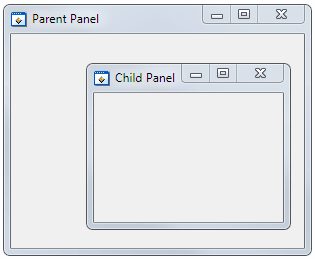Operating Panels
- Updated2023-02-21
- 2 minute(s) read
Operating Panels
A panel is a rectangular region of the screen where controls and menu bars reside. Panels provide the backdrop for many different activities, such as interaction with the front panel instruments.
 |
Note To place a panel into the User Interface Editor window, select Create»Panel. |
Panels operate like windows. You can minimize panels, resize them, move them, and overlap multiple panels. Panels can contain other panels, called child panels. An example of a child panel within a parent panel appears in the following figure. Child panels can appear within other child panels. You cannot drag a child panel outside its parent panel. If you shrink a parent panel, a child panel might be partially or completely hidden in the shrunken panel view.

Child Panel within a Parent Panel
You can operate a panel from the keyboard in the following ways:
- Press <Shift-Ctrl> and the up arrow key to move to the parent panel of the current panel.
- Press <Shift-Ctrl> and the down arrow key to move to the child panel of the current panel.
- Press <Shift-Ctrl> and the left or right arrow key to move to rotate between panels at the current level in the panel hierarchy.
- Press <Tab> to move to the next control on a panel.
- Press <Shift-Tab> to move to the previous control on a panel.
You can operate a panel with the mouse in the following ways:
- Click anywhere inside a panel to make it active.
- Click anywhere on a control to make it active.
Related Topics